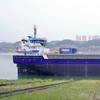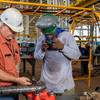DNV: Steel Thickness Measurement
In extending its adherence to delivering cost-efficient and safety driven technologies, DNV has introduced a new means of quickly and accurately determining steel thickness can speed ship surveys. It is especially valuable in inspecting old and corroded steelwork. Present-day methods, based on ultrasonic thickness measurements, are said to have dubious reliability on heavily corroded plates, and for large vessels are also considered too slow. The basic technological challenge was to transmit 100 percent of the signal energy through corroded steel plates, and receive and interpret the reflected signal to give an accurate thickness measurement. The basic principles of the new measuring method (half-wave resonance) have been known for 40 years. But their application was not technically feasible until recently due to lack of data power and limited transmitter technology. A novel method for analyzing acoustic frequency spectra has been developed jointly by DNV and the Norwegian industrial group Kongsberg Defense & Aerospace through an exclusive cooperation agreement.
The measuring method has extreme accuracy in both air and water. The mean strength thickness is processed over a chosen area, providing for further analysis and planning. No removal of scaling and other corrosion products is required, nor of marine growth. On-line digital registration and processing of inspection data is incorporated. The new technology in part, is designed to revolutionize steel-thickness measurements of corroded surfaces.
Jotun Sea Quantum: Tin Free Coating Coverage
Bringing its first cargo to Europe following completion by Samsung Heavy Industries, the 306,000-dwt British Pioneer has given new expression to environmental-consciousness in the crude oil transportation sector. The ship’s potential impact on marine life has been lessened through the adoption of a newly unveiled, tin-free antifouling. Jotun's SeaQuantum product is claimed to stand shoulder-to-shoulder performance-wise with the tin-bearing self-polishing paints, which have enabled shipowners to operate at drydocking intervals of up to 60 months. While Jotun developed the formulation for the coating, Japanese chemicals group Nippon Oil and Fats (NOF) came up with a silyl polymer to replace the environmentally hazardous tin compounds used in the ubiquitous self-polishing antifouling coatings. Multiple full-ship pilot applications over the past seven years provide Jotun with the basis for its claims for the long-run potency and also enhanced fuel-saving effect of the system. British Pioneer, first of a quartet for BP Amoco Shipping, is one of a host of newbuilds to be treated with the copper-based underwater coating.
Astano: Discovery Deep Seas
The last in the series of three Ultra Deep Water (10,000 ft.) Dynamic Position Drilling Units — Discovery Deep Seas — built by Astilleros Españoles' Astano yard in Ferrol was completed last month and heading to the U.S. for final outfitting. The 834-ft. (254.4-m) vessel series successfully embodies myriad shipbuilding and offshore technology innovations, and stands as a powerful reminder of the engineering expertise and quality construction offered by Astano. As of early May, Discovery Deep Seas had been slipped down the delivery ways at the Astano yard and taken position at neighboring Bazan — to take advantage of the yard's deeper draft availability — for final fitting of the six Aquamaster thrusters. For additional information on the technical specifications and achievements by Astano regarding the Discovery drilling unit series, please see related story on page 7 of this edition.
Exmar Offshore Co.: Patented Semisubmersible
With the world offshore market roaring back to life and an estimated $800 million to $1.9 billion to be spent on semisubmersible units over the next five years, Exmar Offshore is nicely positioned to prosper with a patented system. Exmar Offshore earlier this year received a U.S. Patent (#6,015,245) on its semisubmersible hull form, its ring pontoon semisubmersible. The hull form has been the basis of Exmar's series of semisub designs for drilling and floating production applications, the Exmar 2500 and Exmar II design series. The configuration is designed to allow for significant motion characteristics improvement, while reducing current drag. The hull configuration is also characterized by its inherent structural efficiency and ease of construction. There are two design series based on the patent, the four-column Exmar II and the six-column Exmar 2500 semi-submersibles. The main feature of the hulls is the "ring" pontoon configuration. It provides significant reduction of current drag when compared with conventional semi-submersibles with two parallel pontoons. The Exmar patent consist on the proper position of the pontoons with respect to the columns, which allows for cancellation of hydrodynamic forces in waves, thus providing for better motions in waves. Note picture with the yellow hull form. This hull shape takes full benefit of the Exmar patent so that motions reductions in waves are significant.
Mega-Float:Project Takes World Record
The Japanese-built Mega-Float was officially recognized by Guinness World Records Ltd. as the largest man-made floating island. The structure measures 3,280 x 397 ft. (1000 x 121 m) and is 10 ft. (3 m) deep, and was opened to the public on August 10, 1999 at Yokosuka Port, Tokyo Bay, Tokyo. R&D on the structure was initiated in 1995, supported by the Japanese Ministry of Transport and Nippon Foundation. The aim of the joint shipbuilding/steel industry project: meet demand for utilization of ocean space and supplementing conventional landfill methods. From the beginning of June to the end of October 2000, Mega-Float is scheduled to be used for take-off and landing experiments to demonstrate its functionality as an airport.
Ellicott Leads Dredging in the 20th Century
When World Dredging Mining & Construction named its top 10 technical innovations of the 20th century together with the top 10 marine dredging projects, the Ellicott name was omnipresent for its role in three of the 10 technical innovations: Development of the cutter suction dredge; Development of the portable dredge by Mud Cat; Development of the bucketwheel suction dredge. No other manufacturer or designer was cited for as many technical innovations as Ellicott. Of the 10 largest dredging projects, Ellicott equipment was used in more than half, including the industrial land reclamation in Japan and the construction and expansion of the Panama Canal.
Kvaerner Masa-Yards: Voyager of the Seas
While it may not hold its title as world's largest for long, the Kvaerner Masa-Yards-built and Royal Caribbean-owned Voyager of the Seas cruise ship is an innovative marine structure in every sense of the word. The gargantuan ship — able to carry a maximum of 3,840 passengers and 1,180 crew — has cut a figure of unprecedented scale in the passenger ship sector. At 137,200-gt the cruise ship offers a towering superstructure and an air draft of 208-ft. (63.5-m), with a draft of just over 28-ft. (8.8-m). The achievement comes with an equally sizable price. Although the shipbuilding price from KMY was around $500m RCL estimates that its overall project expenditure in bringing it to the market was closer to $700m.
MAN B&W: Intelligent Engine
MAN B&W has been at the forefront of diesel engine development since its inception more than a century ago. The organization, which boasts one of the stronger R&D reputations in this and general power markets, has continuously developed and delivered to market a broad spectrum of propulsion innovations with an eye on fuel efficiency, emission reduction and reduction of life-cycle costs.
The Intelligent Engine is the latest development, a computer-controlled low speed crosshead engine. The basic goal of the development is to reduce the cost of operating the engine and to provide a high degree of flexibility in terms of its operating modes. While the use of electronic systems within the primary propulsion environment has not been traditionally embraced by the maritime market, the need for flexibility to cope with diversified emission limits and increasing demands for reliability will undoubtedly raise the acceptance level. The three major areas of concern involve:
•Enhanced engine reliability, including on-line monitoring to ensure uniform load distribution among cylinders and significantly improved low load operation;
•Enhanced emission control flexibility, including emission performance characteristics optimized to meet local demands and the ability to update at a later date; and
•Reduced fuel and lube oil consumption, including optimizing engine performance fuel at all load conditions and ensuring "as new" performance over the engine lifetime.
Development of the IE is now in phase three, and the IE concept is demonstrated in full scale on the chemical carrier M/T Bow Cecil, built at Kvaerner Floro Yard in Norway for Norwegian owner Odfjell ASA. The main engine of the vessel is a 6L60MC, which was prepared for the IE system during production. Figure 1 shows how the IE systems are installed on the upper gallery of the engine, in parallel with the conventional camshaft. With this set-up, it is possible to change over completely from the conventional system to the IE system or vice versa within about three hours.
The first commercial reference for the Intelligent Engines will be found aboard two trend-setting V-Max 314,500-dwt shallow draft VLCCs (figure 2) being built at Hyundai for Concordia Maritime. Each ship will have a pair of 7S60ME-C engines, and the first vessel is scheduled for delivery in March 2001. Besides the mechatronics drive for the fuel injection system and exhaust valve actuation, the engines will have a computer controlled starting air system and new computer controlled cylinder lubricators, ensuring low cylinder lube oil consumption.
Wärtsilä NSD:
Starts Work On Smokeless Diesel Engine
Wärtsilä NSD has combined resources with Carnival Corp. to develop a smokeless diesel-electric propulsion system for cruise ships. The bold move, hardly a surprise given the Finnish engine maker's penchant for developing and delivering next generation technological innovations in the fiercely competitive marine diesel engine realm, gives a clear indication as to the effects of environmental concerns to the daily operation of marine companies. Code-named "project enviroengine," prototypes of the new engine are expected to be available later this year for laboratory testing and are expected to be available commercially in 2001.
In line with this announcement, the engine maker announced that Daniel Paro BSc (Eng.), who has headed Research & Development for many years, will take responsibility from a technology standpoint for the launch of Wärtsilä NSD's new-generation smokeless engines. Summarily, Prof. Matti Kleimola, Lic.Tech. has been appointed group vice president, Technology and a member of Wärtsilä NSD's Board of Management, effective July 15.
Following successful completion of testing, Carnival plans to utilize those engines on its future newbuilds. According to Captain Jim Drager, Carnival's vice president of corporate shipbuilding, when complete, the enviroengine, installed in a diesel-electric propulsion system, will be one of the most environmentally friendly power plants available for ships. "We have studied the attributes of gas turbines, which we are considering installing on several Carnival Corp. newbuilds now under contract, but still believe that eventually our current diesel- electric systems can be as environmentally friendly as gas turbine alternatives," he said. Drager pointed out that because of efficiency, diesel-electric systems are far less taxing on precious fossil fuel assets and also emit substantially less carbon dioxide to the atmosphere, which is the number one contributor to global warming. According to Paro, the enviroengine is being created by combining "common rail technology" with a direct water injection system. Common rail technology uses an electronically controlled method to inject the precise amount of fuel at exactly the right time, resulting in greater engine operating efficiency and virtually eliminating smoke emissions. Direct water injection reduces nitrous oxide emissions by spraying water into the combustion chamber to cool it down immediately prior to injecting the fuel. Cooling down the chamber reduces nitrous oxide formation, which occurs at high temperatures. This method reduces nitrous oxide emission value to the same level as gas turbine engines. Paro said, Since the mid-1980s, Wärtsilä NSD has spent more than $100 million (U.S.) on emission reduction research." He added that Wärtsilä will have spent more than $10 million (U.S.) on the enviroengine development before the prototype testing models are even built.
Featured videos

Tracking Foreign Vessels Working in the U.S. Jones Act Market

Inmarsat Enhances Service to Drive Digitalization

Inside the Electrified Truckable Tug
Subscribe for
Maritime Reporter E-News
Maritime Reporter E-News is the maritime industry's largest circulation and most authoritative ENews Service, delivered to your Email five times per week









